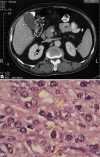Isolated Splenic Mycobacterial Disease: A Cause of Persistent Fever in a Hairy Cell Leukemia Patient
- PMID: 21060695
- PMCID: PMC2974994
- DOI: 10.1159/000320639
Isolated Splenic Mycobacterial Disease: A Cause of Persistent Fever in a Hairy Cell Leukemia Patient
Abstract
We describe a 69-year-old male patient who was referred for the investigation of long-lasting fever, anemia and neutropenia. Hairy cell leukemia was diagnosed and treated successfully. However, fever persisted despite thorough investigation and use of broad-spectrum antibiotics. Four months after the initial diagnosis, the patient underwent explorative laparotomy and splenectomy. Spleen biopsy revealed multiple necrotizing mycobacterial granulomata while the patient's fever disappeared permanently. Isolated splenic mycobacterial disease is very rare. This case report emphasizes that investigation of chronic fever in hairy cell leukemia requires a high level of clinical suspicion. Early diagnostic procedures for evidence of atypical mycobacterial infection should be considered. When everything else fails, surgery can be helpful in selected cases.
Figures
References
-
- Flinn IW, et al. Long-term follow-up of remission duration, mortality, and second malignancies in hairy cell leukemia patients treated with pentostatin. Blood. 2000;96:2981–2986. - PubMed
-
- Goodman GR, Burian C, Koziol JA, Saven A. Extended follow-up of patients with hairy cell leukemia after treatment with cladribine. J Clin Oncol. 2003;21:891–896. - PubMed
-
- Damaj G, et al. Risk factors for severe infection in patients with hairy cell leukemia: a long-term study of 73 patients. Eur J Haematol. 2009;83:246–250. - PubMed
-
- Zinzani PL, et al. Long-term follow-up of front-line treatment of hairy cell leukemia with 2-chlorodeoxyadenosine. Haematologica. 2004;89:309–313. - PubMed
-
- Else M, et al. Long remissions in hairy cell leukemia with purine analogs: a report of 219 patients with a median follow-up of 12.5 years. Cancer. 2005;104:2442–2448. - PubMed
Publication types
LinkOut - more resources
Full Text Sources


